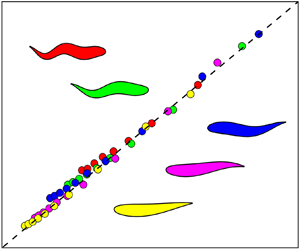Crossref Citations
This article has been cited by the following publications. This list is generated based on data provided by
Crossref.
Chao, Li-Ming
Alam, Md. Mahbub
and
Cheng, Liang
2022.
Hydrodynamic performance of slender swimmer: effect of travelling wavelength – ERRATUM.
Journal of Fluid Mechanics,
Vol. 948,
Issue. ,
Wei, Chang
Hu, Qiao
Li, Shijie
and
Shi, Xindong
2023.
Hydrodynamic interactions and wake dynamics of fish schooling in rectangle and diamond formations.
Ocean Engineering,
Vol. 267,
Issue. ,
p.
113258.
Shukla, Sarvesh
Sharma, Atul
Agrawal, Amit
and
Bhardwaj, Rajneesh
2023.
Flow over a hydrofoil subjected to traveling wave-based surface undulation: effect of phase difference between surface waves and wave number.
Theoretical and Computational Fluid Dynamics,
Vol. 37,
Issue. 3,
p.
319.
Lin, Zhonglu
Liang, Dongfang
Bhalla, Amneet Pal Singh
Sheikh Al-Shabab, Ahmed A.
Skote, Martin
Zheng, Wei
and
Zhang, Yu
2023.
How wavelength affects hydrodynamic performance of two accelerating mirror-symmetric undulating hydrofoils.
Physics of Fluids,
Vol. 35,
Issue. 8,
Lin, Zhonglu
Zheng, Wei
Zhang, Jinhu
Ou, Wenzhan
Yang, Chen
Huang, Hongbin
Xu, Wenjun
Yang, Zhuoyuan
Zhou, Wei
and
Zhang, Yu
2023.
Mudskipper-inspired amphibious robotic fish enhances locomotion performance by pectoral-caudal fins coordination.
Cell Reports Physical Science,
Vol. 4,
Issue. 10,
p.
101589.
Lin, Zhonglu
Bhalla, Amneet Pal Singh
Griffith, Boyce E.
Sheng, Zi
Li, Hongquan
Liang, Dongfang
and
Zhang, Yu
2023.
How swimming style and schooling affect the hydrodynamics of two accelerating wavy hydrofoils.
Ocean Engineering,
Vol. 268,
Issue. ,
p.
113314.
Alam, Md. Mahbub
2023.
Fish peduncle response during forward and backward propulsion.
International Journal of Advanced Robotic Systems,
Vol. 20,
Issue. 1,
Kang, Linlin
Xiong, Shiying
Wu, Buchen
Li, Chao
Ge, Mingming
Yuan, Dehan
Han, Fei
and
Cui, Weicheng
2023.
Force decomposition on flapping flexible plate via impulse theory and dynamic mode decomposition.
Physics of Fluids,
Vol. 35,
Issue. 10,
Anastasiadis, Alexandros
Paez, Laura
Melo, Kamilo
Tytell, Eric D.
Ijspeert, Auke J.
and
Mulleners, Karen
2023.
Identification of the trade-off between speed and efficiency in undulatory swimming using a bio-inspired robot.
Scientific Reports,
Vol. 13,
Issue. 1,
Wang, Siyuan
Xu, Peng
Liu, Jianhua
Wang, Hao
Si, Jicang
Deng, Jian
Xu, Minyi
and
Wang, Zhong Lin
2023.
Underwater triboelectric nanogenerator.
Nano Energy,
Vol. 118,
Issue. ,
p.
109018.
Stin, Vincent
Godoy‐Diana, Ramiro
Bonnet, Xavier
and
Herrel, Anthony
2024.
Form and function of anguilliform swimming.
Biological Reviews,
Vol. 99,
Issue. 6,
p.
2190.
Chao, Li-Ming
Couzin, Iain D.
and
Li, Liang
2024.
On turning maneuverability in self-propelled burst-and-coast swimming.
Physics of Fluids,
Vol. 36,
Issue. 11,
Shukla, Sarvesh
Sharma, Atul
Agrawal, Amit
and
Bhardwaj, Rajneesh
2024.
Fish-Inspired Oscillating and/or Undulating Hydrofoil in a Free Stream Flow: A Review on Thrust Generation Mechanisms.
Journal of the Indian Institute of Science,
Vol. 104,
Issue. 1,
p.
147.
Li, Shijie
Hu, Qiao
Zhang, Tangjia
Shi, Xindong
Zeng, Yangbin
Chen, Long
Wei, Hongbo
Zhang, Jinhua
and
Guo, Chunyu
2024.
Bionic parallel undulating fins: Influence of unsteady coupling effect on robot propulsion performance.
Ocean Engineering,
Vol. 312,
Issue. ,
p.
119075.
Li, Ruoxin
Wang, Pengfei
Liu, Yuanchuan
Yu, Kai
and
Han, Yang
2024.
Parametric analysis on the acoustic characteristics generated by a biomimetic swimmer.
Ocean Engineering,
Vol. 305,
Issue. ,
p.
118002.
Chao, Li-Ming
and
Li, Liang
2024.
Hydrodynamic Interactions in Schooling Fish: Prioritizing Real Fish Kinematics Over Travelling-wavy Undulation.
p.
16895.
Chu, Wenhua
Yan, Jifeng
Cao, Yu
and
Zhao, Zijing
2024.
Study on the influence of queue modes on the hydrodynamic performance of fish schooling swimming.
Physics of Fluids,
Vol. 36,
Issue. 3,
Yang, Dewu
Wu, Jie
Khedkar, Kaustubh
Chao, Li-Ming
and
Bhalla, Amneet Pal Singh
2024.
Hydrodynamics and scaling laws for intermittent S-start swimming.
Journal of Fluid Mechanics,
Vol. 984,
Issue. ,
Li, Ruoxin
Wang, Pengfei
Jia, Laibing
Han, Yang
and
Yu, Kai
2024.
Effect of leading and secondary vortices on the propulsion performance of an undulating swimmer in the periodic vortex street.
Applied Ocean Research,
Vol. 150,
Issue. ,
p.
104119.
Li, Xiaohu
Chen, Gong
Tang, Yanbing
and
Zhong, Jisong
2024.
Hydrodynamic analysis of the upright swimming of seahorse.
Physics of Fluids,
Vol. 36,
Issue. 2,
